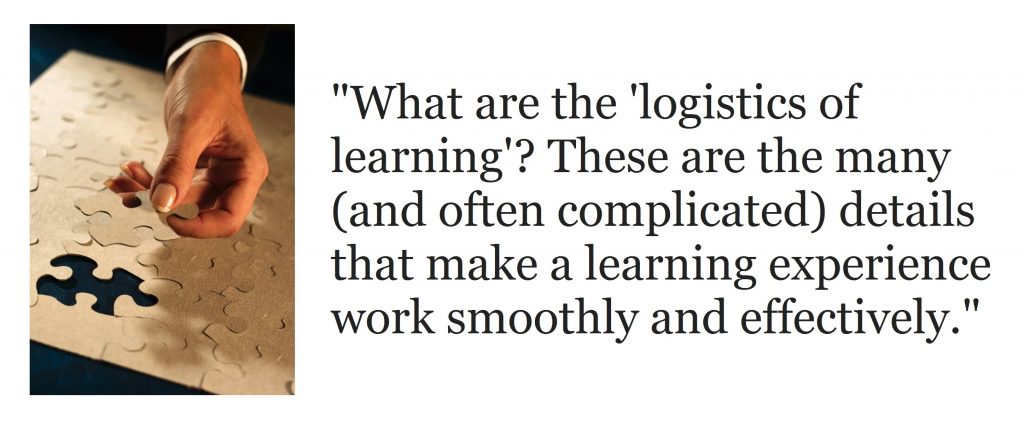There have been a couple of situations recently that made me think of an aspect of Fredrickson’s custom learning development business that we don’t talk about often, but where I think we really excel: the logistics of learning.
What are the “logistics of learning”? These are the many (and often complicated) details that make a learning experience work smoothly and effectively. For everyone! Both for the target audience, and for the sponsor, who is generally our client.
The logistics of learning are different for every program, but with the collective experience here at Fredrickson, we’ve developed a very good sense for where the logistical tripping points lie. A couple of examples to show you what I mean.
We had a client last year who came to us with a major new software rollout in the works. This software was for their dealer network, it was a complete overhaul of the application that the dealers use to quote the prices for this company’s products. They wanted to do live instructor-led sessions for all their dealers, nationwide, and since these are the people who sell this company’s products, they needed it to go smoothly and be an effective learning experience.
There are many of “logistics of learning” issues that come up in a program of this scale. To focus on just one example, as we developed a training program approach and estimate, we brought to the client’s attention that we saw a need to budget for mobile computer labs. These labs included laptops, monitors, network hubs, cables, and so forth. All packed in a shipping case that could survive a hit from a cruise missile.
“Can’t we just have the dealers bring their own laptops to the training?” That was the client’s question, and it seems like a simple way to avoid a considerable expense. But our experience with the logistics of learning told us the answer was “no” and here’s why.
Because of the extremely limited time and the importance of this training to the client, allowing the dealers to use their own laptops would introduce a technology wildcard that could easily eat up precious minutes of every session. It would just be too big of a drag on the overall experience and too big of a risk for the program. Despite the considerable cost, the goals and constraints of the program indicated that this expense was worth considering, given the risks that not doing it would bring into play.
Another example of the logistics of learning. Recently, we had a client who came to us with a series of eLearning courses (developed by another vendor). These courses were customer-facing, which, increasingly these days, means the customers are accessing them on mobile devices. But the courses weren’t designed for mobile delivery, they were designed for the desktop or laptop. The client’s request was that we test the courses and tell them what it would take to “make sure the courses work on everything.”
A perfect example of a logistics of learning issue. There’s a lot more “everything” out there when it comes to mobile devices than most people realize. Smart phones, phablets, tablets, laptops, and desktops. To make it even more interesting, these devices are all running various operating systems, versions, variants, and with varying browser types and browser versions on top of it all. Wow. It makes my head spin.
And the next question is, “Even if you could make it work on everything, do you really want to?” Given the amount of money it would cost and relatively small user bases for certain configurations, making something that works on everything can be a very expensive proposition. We helped the client understand that it’s better to find a sweet spot in their mobile user base and focus on making sure their eLeaning and mLearning products work on their user’s most common devices first.
One of our Fredrickson consultants created a matrix for the client that showed them where the real bang for the buck was in terms of overall users. A little bit of planning and prioritization can save a lot of time, effort, and money.
Now this wasn’t the simple answer the client was hoping for, and that brings up an important point about the logistics of learning. They often they put us in the uncomfortable position of having to point out that what seemed like a simple need is actually more complicated than our client may have envisioned. And let’s be honest, “more complicated” often equals “more expensive.”
[rs-image img_url=”http://fredricksonlearning.com/wp-content/uploads/2014/12/Easy-button.bmp” link=”” alt=”” width=”” height=”” class=”” type=”img-rounded” border=”default” new_win=”no” margin=”” pos=”pull-left” wrap=”no”/]
Everybody wants the Easy Button, but as Albert Einstein is often quoted as saying, “Everything must be made as simple as possible, but no simpler.” We agree with our friend Albert in this regard. We want simple, but we also want success.
We want our clients to have as smooth a ride as possible and to be successful when they hire us. To make this a reality, we feel the obligation to use our experience with the logistics of learning to help figure out what’s really important in order to accomplish the client’s vision and business goal.

